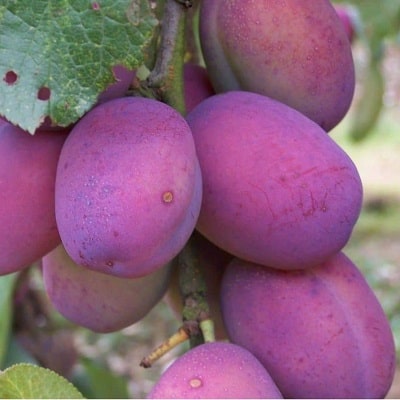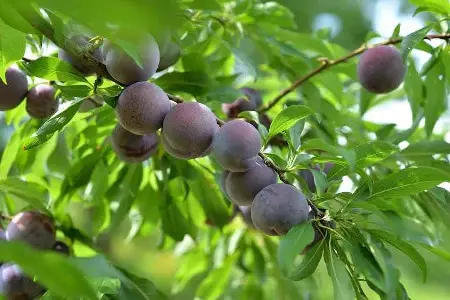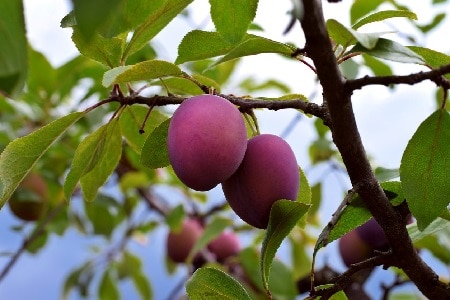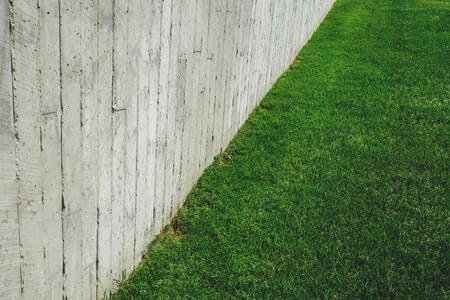Plum trees are a beautiful addition to any garden. They produce sweet, juicy fruits that can be used in many recipes. But how do you grow a plum tree from a seed?
Plum seeds need to be planted with no more than two inches of soil cover and they should be watered thoroughly after planting. The best time to plant your new plum tree is in the late fall or early spring (October through May). Where you decide to plant the seeds of your new plum tree will determine whether it needs full sun or partial shade.
This article will serve as a guide of sorts, explaining the tools you will need and steps to take. We’ll take you through every process so that soon enough you’ll have plums that are ripe for the picking.
Benefits of Plums
Plums are not just tasty – they’re also healthy! They contain a lot of Vitamin C, antioxidants, and fiber. That’s why plums have been deemed one of the ten healthiest fruits to eat this year by Health Magazine (1).
Some health benefits associated with plums as as follows,
- Helps to prevent heart diseases.
- Boosts the antioxidants in your blood, thereby reducing anxiety.
- Helps rid your body of excess sodium, thus reducing high blood pressure.
- It is rich in vitamin C and helps with healing.
Plums are an excellent source of vitamin C and potassium. They also contain antioxidants, which help the body fight off free radicals that cause inflammation and other problems. The high fiber content in plums helps lower cholesterol levels.
Finally, plums have been shown to reduce the risk of colon cancer when eaten every day for at least a month (2).
What do you need to plant a plum pit?
Plums are a delicious summer fruit that can be grown in your own backyard. Here’s what you need to plant a plum pit:
- A pot for the tree to grow in when it is small.
- Soil rich with nutrients and organic matter, such as compost or manure.
- Planting mix or mulch for the top of the soil around the tree roots
Because plum Pits are grown in two stages, you will also need the following items.
- Jar: This serves as storage for the plum pits.
- Lots of Paper Towels: These keep the plum pits moist for germination.
- Water: This must be available in adequate amounts.
- Refrigerator: This provides the appropriate temperature for plant
- Loamy soil: This is the ideal soil type recommended for their growth.
Planting Plum Pits
Plums are easy to maintain, making them a great choice for those who don’t have much experience growing and tending to plants. To plant a plum pit, the major factor that needs to be present is the soil. Once you have soil that is suitable with favorable environmental conditions and an adequate supply of water, anyone can plant a plum pit easily.

Plum pits are grown in two stages, with the first stage needed to induce germination of the plum pit. Unlike most other plants where you plant seeds and simply wait for them to grow into a tree or flower, plums need different temperatures before they can be planted and thrive – which is why this process takes so much time!
Preparing the Plum Pit
The first step is preparing the plum pit. After harvesting the plum pit, wash it in water that is a bit warm. Using a soft scrub brush, remove any pulp present on the seed. Once this is complete, you will need to store the seed at cold a temperature before it can germinate. Temperatures between 1 – 5°C (33 – 41°F) are best for the plum pits.
Once you met these criteria, the plum pit should germinate and produce a sprout in about 10 to 12 weeks. You will need to monitor the pit as it can sometimes sprout earlier than expected. This can be achieved by a natural process, where the seed is planted in the winter and the natural cold of the winter helps to germinate the plum pit or by refrigerating the plum pit.
Germination Using the Natural method
The plum pit should be placed at about 3 inches (8 cm) into the ground in this method. After this, the plant will begin to sprout, and by winter’s end, it can begin to grow. In this method, you are advised to apply some organic matter to the soil before planting. Almost any organic matter will do, provided it isn’t fertilizer.
This should be done about a month to the planting date, to help improve the quality of the soil before planting the plum pit. You will need to place some identifier on the planting spot, so you can find it later on. Ensure you monitor the location closely in case the pit produces a sprout early. Once a sprout is found, ensure the sprout is moist and the plant will grow without any interruptions.
Germination Using the Controlled method (refrigerator method)
In the controlled method, the plum pit is first planted in a jar, wrapping the pit in a moist paper towel, and stored in a refrigerator. Adjust the refrigerator to suit the temperature requirements of the plum pits.
Once the pit develops a sprout, move the sprout to a new container with soil that is easily drained. The soil should be a mixture of potting soil and vermiculite. Place the new container in a new location that is cool and bright. Ensure the plant has adequate moisture, but be careful as it can become damp, which isn’t ideal for the plum. This process will continue until the plant is no longer in danger from frost.

After this process is complete, you can transplant the plum into the permanent site. Endeavor to maintain the original depth of the plum pit when transplanting into the permanent site.
The conditions needed for the permanent site includes:
- The hole needs to be at least 12 inches (31 cm) deep.
- Access to at least 6 hours of uninterrupted access to sunlight.
- Compost can be mixed in with the soil to make it richer.
- Ensure there are no rocks or debris present in the soil.
How to Prepare the Soil for Plum Trees
Plum trees are a beautiful addition to any garden. They provide a sweet, juicy fruit that can be used in many different ways. However, before you plant your plum tree, it is important to prepare the soil properly for planting. Whether you have clay or sandy soil, there are certain techniques and tips that will help your new plum tree thrive!
To help improve your plum tree’s growth and performance you should consider loosening up compact soil and replenishing its vitamin and mineral content.
Loosening compact soil is important because it helps the plum’s roots spread out easily. To do this, you must make a mixture of cow manure, compost, peat moss, and lime and add it to your topsoil. Your garden may not be rich in loamy soil but other soil types will do if they are maintained as needed to grow plum trees.
Once you have met all the requirements and followed all the steps, all that is left is for you to exercise a little patience. The average time for a plum tree to bear fruit in five years. In some cases, you can see fruits as early as four years and sometimes as late as six years.
It is important to continue to water the plant, apply compost to the soil around the tree until it bears fruits. Once this is complete, a plum tree can last up to 30 years, producing fruit once in two or three years.
You will eventually not only get great plums, but you’ll have carried out a fun long-term project in the process.






